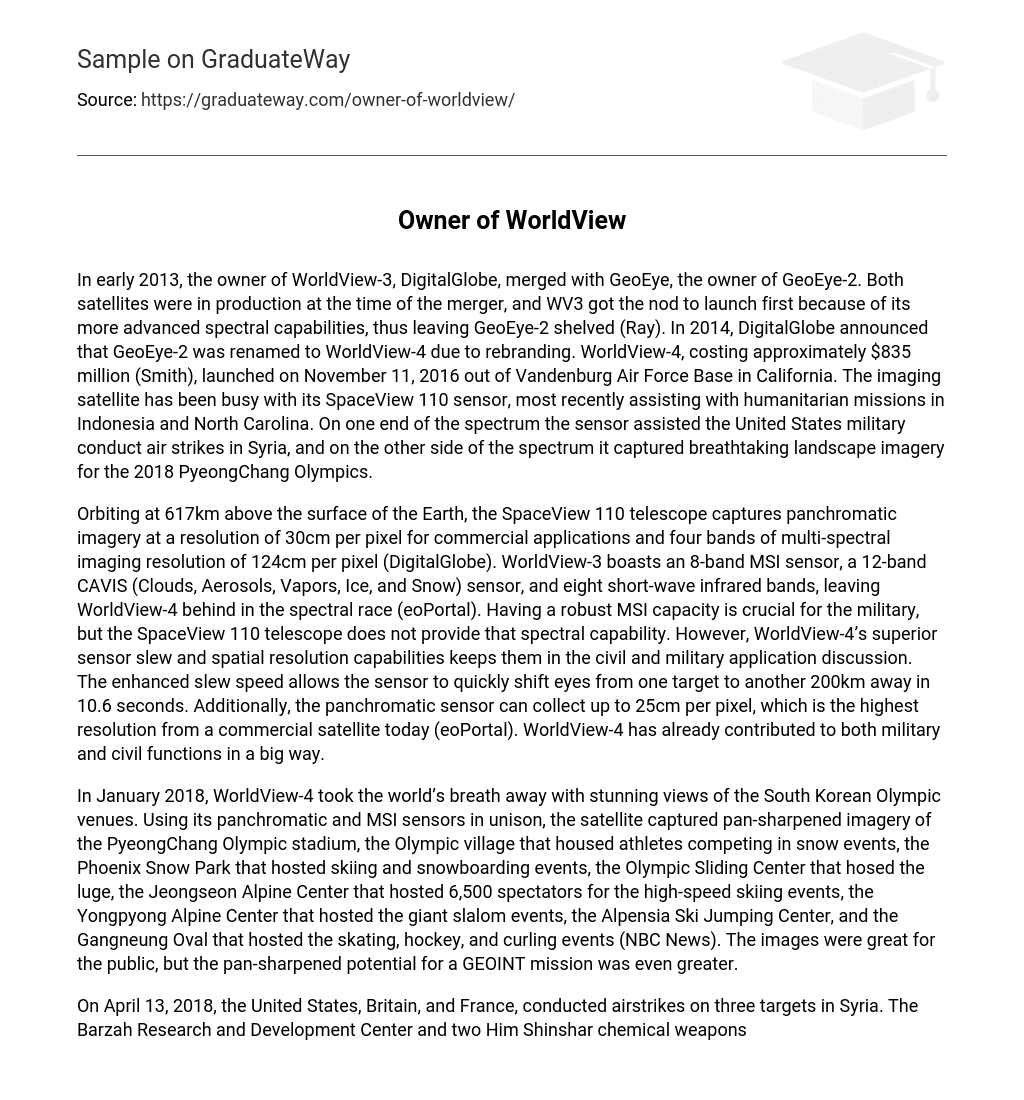In early 2013, the owner of WorldView-3, DigitalGlobe, merged with GeoEye, the owner of GeoEye-2. Both satellites were in production at the time of the merger, and WV3 got the nod to launch first because of its more advanced spectral capabilities, thus leaving GeoEye-2 shelved (Ray). In 2014, DigitalGlobe announced that GeoEye-2 was renamed to WorldView-4 due to rebranding. WorldView-4, costing approximately $835 million (Smith), launched on November 11, 2016 out of Vandenburg Air Force Base in California. The imaging satellite has been busy with its SpaceView 110 sensor, most recently assisting with humanitarian missions in Indonesia and North Carolina. On one end of the spectrum the sensor assisted the United States military conduct air strikes in Syria, and on the other side of the spectrum it captured breathtaking landscape imagery for the 2018 PyeongChang Olympics.
Orbiting at 617km above the surface of the Earth, the SpaceView 110 telescope captures panchromatic imagery at a resolution of 30cm per pixel for commercial applications and four bands of multi-spectral imaging resolution of 124cm per pixel (DigitalGlobe). WorldView-3 boasts an 8-band MSI sensor, a 12-band CAVIS (Clouds, Aerosols, Vapors, Ice, and Snow) sensor, and eight short-wave infrared bands, leaving WorldView-4 behind in the spectral race (eoPortal). Having a robust MSI capacity is crucial for the military, but the SpaceView 110 telescope does not provide that spectral capability. However, WorldView-4’s superior sensor slew and spatial resolution capabilities keeps them in the civil and military application discussion. The enhanced slew speed allows the sensor to quickly shift eyes from one target to another 200km away in 10.6 seconds. Additionally, the panchromatic sensor can collect up to 25cm per pixel, which is the highest resolution from a commercial satellite today (eoPortal). WorldView-4 has already contributed to both military and civil functions in a big way.
In January 2018, WorldView-4 took the world’s breath away with stunning views of the South Korean Olympic venues. Using its panchromatic and MSI sensors in unison, the satellite captured pan-sharpened imagery of the PyeongChang Olympic stadium, the Olympic village that housed athletes competing in snow events, the Phoenix Snow Park that hosted skiing and snowboarding events, the Olympic Sliding Center that hosed the luge, the Jeongseon Alpine Center that hosted 6,500 spectators for the high-speed skiing events, the Yongpyong Alpine Center that hosted the giant slalom events, the Alpensia Ski Jumping Center, and the Gangneung Oval that hosted the skating, hockey, and curling events (NBC News). The images were great for the public, but the pan-sharpened potential for a GEOINT mission was even greater.
On April 13, 2018, the United States, Britain, and France, conducted airstrikes on three targets in Syria. The Barzah Research and Development Center and two Him Shinshar chemical weapons complexes were destroyed by 105 missiles, setting Syria back years in chemical weapons capabilities (Sonne). WorldView-4 imagery taken before and after the airstrikes showed the Battle Damage Assessment (BDA) in pan-sharpened imagery, allowing the United States and its allies to positively assess the targets pre and post strikes. WorldView-4 demonstrated their capability of supporting military missions, but its applications can have a role to play in saving lives, also.
On September 14th, 2018, Hurricane Florence collided with North Carolina with 90mph winds, killing 27 people, plus an additional nine in South Carolina and three in Virginia (Dyke). In the following week, WorldView-4 provided hi-resolution imagery that highlighted the damage, enabling services to focus their efforts on the most flooded areas. It wouldn’t be long until the satellite would assist the civil community again, but this time on the other side of the world.
On September 28th, 2018, the Indonesian island of Sulawesi was rocked by a 7.5 magnitude earthquake that resulted in a tsunami, killing in excess of 1,400 people and displacing tens of thousands more (Reuters). Search and rescue missions were conducted for weeks, as searchers struggled to sift through the ruins, while food and water were in short supply. WorldView-4 provided imagery of the worst hit areas, allowing rescue workers to focus their searches.
With an estimated 10-12 years of total service life, WorldView-4 has plenty of time left to continue to inspire the imagery community with its industry leading spatial resolution abilities. The agility to scan two times faster than any competitor coupled with its ability to revisit targets daily makes this platform invaluable. The 800mb/sec Wideband Data Downlink rate is the top of its class, and customer sites can directly task the sensor and receive the data. It falls short in the MSI department compared to its WorldView-3 counterpart. Whether its humanitarian efforts, vanity shots, or gathering BDA data for the GEOINT community, WorldView-4 is the big eye in the sky, at least until WorldView-150 launches in 2025 (eoPortal).





